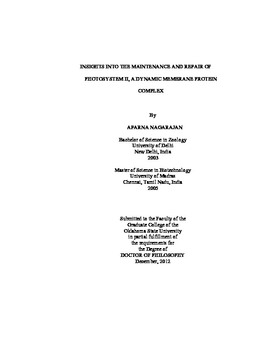| dc.contributor.advisor | Burnap, Robert Lord | |
| dc.contributor.author | Nagarajan, Aparna | |
| dc.date.accessioned | 2015-06-17T20:07:15Z | |
| dc.date.available | 2015-06-17T20:07:15Z | |
| dc.date.issued | 2012-12 | |
| dc.identifier.uri | https://hdl.handle.net/11244/19488 | |
| dc.description.abstract | Photosystem II (PSII) is recognized as the main site for high light induced damage. One of the core subunits of PSII, D1 protein encoded by the psbA gene, is identified as a high turnover protein that undergoes degradation and replacement as a part of the repair process in PSII. Studies on D1 repair have shown the synchronous nature of D1 degradation and synthesis. FtsH a AAA protease, is known to cause D1 degradation. Therefore, it is widely speculated that damaged D1 is replaced by newly synthesized D1. Although, there is no direct evidence suggesting the removal of damaged subunits only. Alternatively, an induction of the general increase in the turnover rate of D1 could trigger the replacement of all D1 subunits in a random fashion. In this work, I have addressed these two alternate hypotheses by developing a genetic system involving dual D1 expression. Strains were constructed with the parallel expression of a WT psbA2 in the ectopic and a damage prone mutant psbA2 at the native locus. Firstly, a WT ectopic strain (eWT) was constructed by transforming a psbA deletion strain with a WT psbA2, which was synthesized using synthetic biology and fusion PCR. Secondly, mutant psbA2 was introduced into the native locus of the eWT strain. All the dual D1 strains showed high PSII activity. Higher PSII levels represent increased proportion of PSII with WT D1 incorporated, as the mutant does not correspond to high PSII levels. Immunoblot analysis of a dual strain nS345P: eWT against D1 did not show an accumulation of the S345P form, which exists as pre-D1. However, deletion of the FtsH protease in nS345P: eWT showed an accumulation of pre-D1 along with mature D1. This indicates that S345P mutant forms are targeted for repair in the dual strain. Additionally, psbA2 gene dosage effect was also studied by expressing two WT psbA2. Similar levels of PSII and D1 were observed in the single and double WT strain. This suggests that level of PSII is being regulated and that D1 is not the regulating factor. Therefore, PSII homeostasis is maintained by some other protein factor. | |
| dc.format | application/pdf | |
| dc.language | en_US | |
| dc.rights | Copyright is held by the author who has granted the Oklahoma State University Library the non-exclusive right to share this material in its institutional repository. Contact Digital Library Services at lib-dls@okstate.edu or 405-744-9161 for the permission policy on the use, reproduction or distribution of this material. | |
| dc.title | Insights into the maintenance and repair of photosystem II, a dynamic membrane protein complex | |
| dc.contributor.committeeMember | Hadwiger, Jeffrey A. | |
| dc.contributor.committeeMember | Hoff, Wouter D. | |
| dc.contributor.committeeMember | Matts, Robert L. | |
| dc.contributor.committeeMember | Shaw, Edward I. | |
| osu.filename | Nagarajan_okstate_0664D_12540.pdf | |
| osu.accesstype | Open Access | |
| dc.type.genre | Dissertation | |
| dc.type.material | Text | |
| dc.subject.keywords | degradation | |
| dc.subject.keywords | homeostasis | |
| dc.subject.keywords | membrane protein | |
| dc.subject.keywords | photodamage | |
| dc.subject.keywords | photosystem II | |
| dc.subject.keywords | repair | |
| thesis.degree.discipline | Microbiology, Cell and Molecular Biology | |
| thesis.degree.grantor | Oklahoma State University | |
